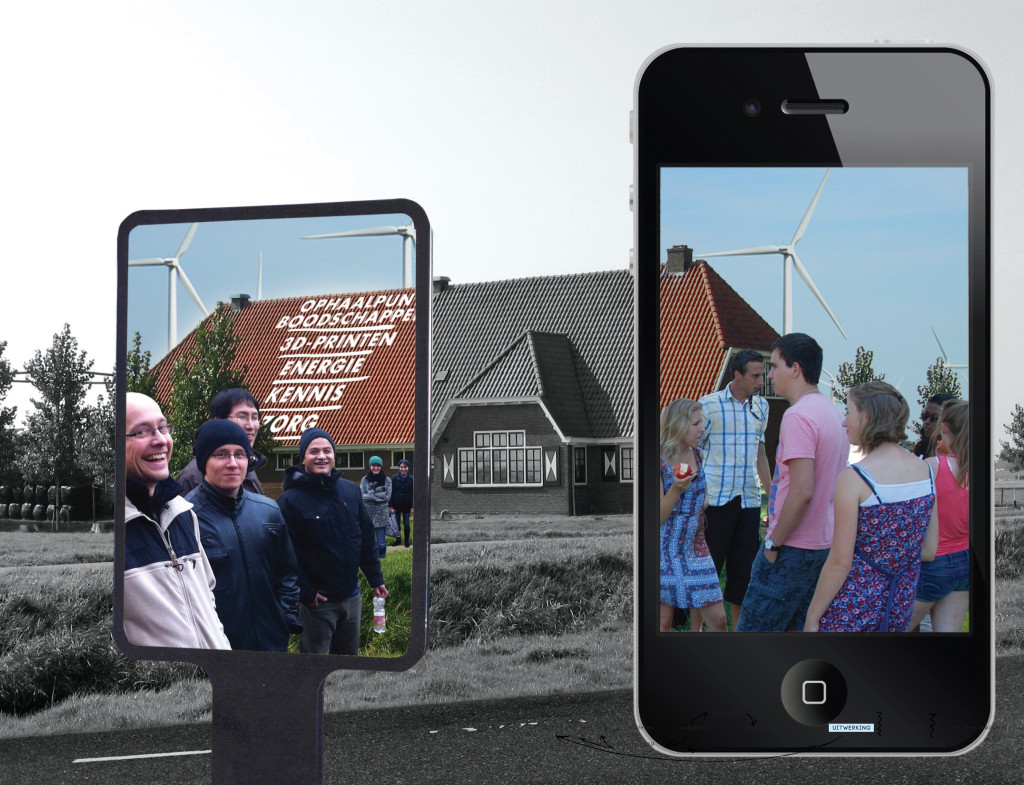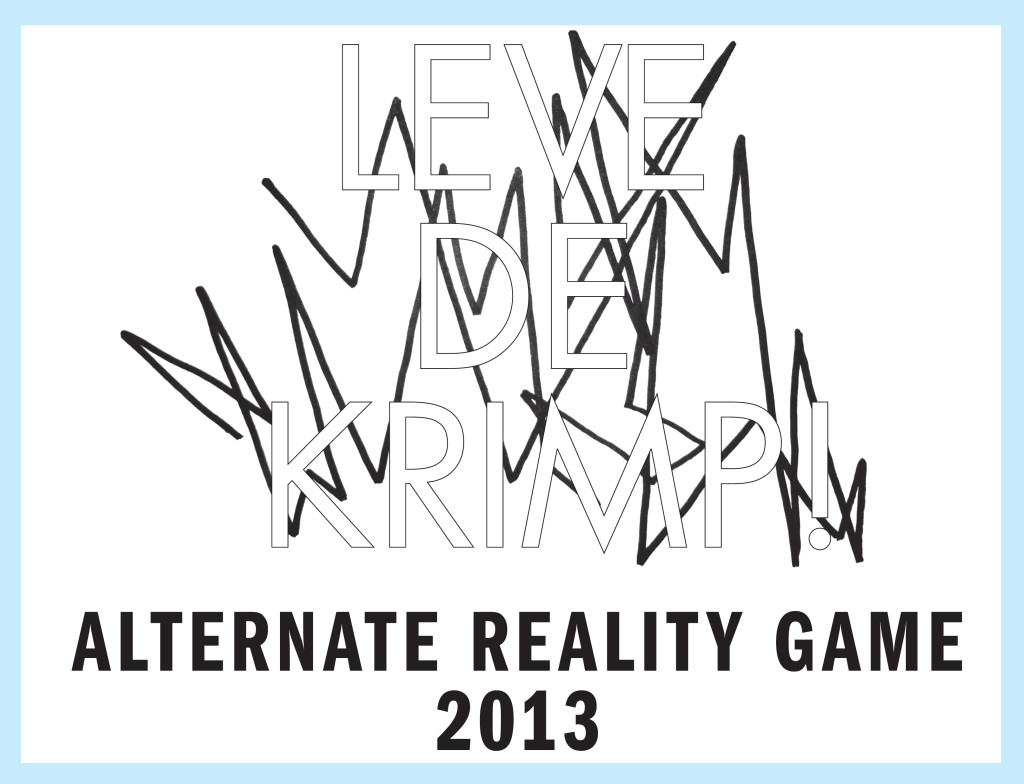Leve de Krimp! // Let’s shrink!
Leve de Krimp! is a public facing alternate reality game that focuses on depopulation, a demographic phenomenon that mostly takes place in peripheral regions. The game creates a sense of urgency, encourages ownership and mobilizes and empowers citizens to positively change the future of their region.
Context
Many professionals and policy-makers acknowledge that in order to anticipate to future demographic changes, it is crucial to have the local inhabitants play their own part in the process. The locals are no longer puppets on the strings of the policy-makers; they are the new heroes. As they are the ones who’ll find themselves living in the areas that are facing shrinkage, they are the ones that’ll experience the consequences of this, like the absence of facilities and jobs, abandoned houses, vacant buildings, decay. More and more it becomes clear that they are the most important stakeholders in these areas. If we truly want to work on pleasant living-conditions within this changing future we shouldn’t fight the shrinkage, but we’ll have to accept the presence and effects of these demographic changes. Only then we can find a way to deploy these demographic challenges for a high(er) quality of life, despite of a quantitative decline of people, money and facilities in an area.
In the game-methodology of Let’s shrink! Studio Papaver focused on the issue of depopulation and shrinking regions. Since depopulation and it’s effects are very abstract for many citizens in shrinking regions, Studio Papaver developed an innovative method to raise awareness, to create citizen-ownership of the problem and to empower and mobilize inhabitants in order to change the shrinking future of their region.
Game methodology
The methodology of Let’s shrink! is based on an Alternate Reality Game. Why a game? A game makes it possible to engage with big issues that are not (yet) present in daily life. A game makes you experience situations in the first person and that makes it very suitable to contribute to raising awareness. Furthermore, a game stimulates people to work together, to be creative and to extend their limits. The fact that they’re ‘just playing’ makes it possible to get loose from rigid reality or patterns.
The Alternate Reality Game is a special gametype. It differs from simulation games. Although the typology may sound very high tech, that’s certainly not the case. This type of game puts an extra layer on reality. It’s not only played in a virtual setting, but also interacts in the ‘physical’ world, being part of daily life. Another characteristic of this type of game is that it’s played over a longer period of time, it’s active for a few months. In the case of Let’s Shrink! players can already experience the future effects of depopulation in their daily lives. So the ‘shrinked’ future is being brought to the present: Play it before you live it!
Very simplified, the game works like this. The game presents a common future in which the dramatic effects of depopulation have become reality there. Players imagine themselves dealing with this situation. They receive assignments that have to do with a certain situation within that common future, but players execute them in their daily lives. So they consider themselves dealing with that common future, but acting on it within their daily lives. The players show their actions on an online platform. On this online platform other players and people can follow the game. And it’s also the place where links can be made between results and ideas of players.
Let’s shrink!
In the Achterhoek – a Dutch region that’s expecting to shrink within several years – a small scale pilot of the game was tested. In this edition of the game, the common future takes place in the year 2039 – as according to prognosis, 2039 is the year in which the ageing of the population will reach its peak. The story of the Achterhoek in the year 2039 isn’t so pleasant. Supermarkets withdraw themselves from the region, as the number of customers is declining. Public transport no longer operates in the Achterhoek as the density of the region has become too low to be profitable. The value of houses has dropped tremendously, so people can’t sell their houses without big debts. Four characters living in the year 2039 tell about how their lives look like, what they experience and what issues they have difficulty with. For example, there is Lia ten Brinke – 74 years old, retired primary school teacher and living in Lichtenvoorde. After her husband passed away she’s living alone on the farm. Her daughters didn’t want to take over the farm. Sinds two years she’s also the only one living in the street, as the other three farms are vacant. She is greatfull that she’s still quite mobile and that she can visit friends, but she doesn’t get many visitors. She would love to live in one of those communities where healthcare, recreation, housing and sports are combined, but it is too expensive and the waitinglist is very long. So only the happy few can live there.
After presenting the common future, the game reveals that Let’s Shrink! is a movement. This movement realizes that the opportunity to keep an area which is nice to live in despite of depopulation, has not been seized. Only the inhabitants of the Achterhoek themselves can make sure the Achterhoek stays a great place to live in, despite of depopulation.
The movement invites people to become a member (player) and perform actions in the present to influence and change that future in a positive way. The movement Let’s shrink! states that the knowledge and creativity of the Achterhoeker is crucial to achieve this goal.
Players receive an assignment in different thematic rounds. For example, one of the assignments in the Achterhoek was about Mobility. Live during three days as if you don’t have your own car, you can’t use public transport and you may not use any services within a range of 10 km. But still you want to be able to do what you’re doing now (go to work/sports/friends/shopping). How do you organize your daily life within these conditions?
The players post their ideas and solutions on the website of Let’s shrink!. In this way, the website visualizes the collective intelligence of the region. Parallel to working on the assignments and creating ideas, the players get messages from the movement Let’s shrink! and receive reactions from the characters living in the future. For example, one of the players who was working on the theme Mobility receive a message from Lia ten Brinke who was wondering what his solution would mean for her live.
After several months – when several thematic rounds with assignments have been played – it’s time to finish the game through a manifestation. The manifestation is linked to a popular local event. During the manifestation the best ideas are being presented and through a film the characters in 2039 show how their lives have positively changed by all the ideas of the Achterhoekers.
Extra thoughts
During the pilot it was noticed that this way of dealing with the phenomenon of depopulation and the effects of it, stimulates awareness, makes people think about it and even makes them act upon it. The ideas that arise might not be spectacular, but the important thing is that the ideas are from the people/the Achterhoekers themselves, concerning the area they live in. And that makes the difference. If you really want people to create a solution or ideas then it’s crucial that they do this out of their own intrinsic motives.
The game proposal was developed by Studio Papaver in collaboration with the graphic designers of We-Are-Amp. Furthermore a sounding-board was established, containing of Kars Alfrink, Martijn de Waal, Peter Scholte, Roy van Egmond and Jan-Bart Wilschut.






Very interesting the combination of a daily physical reality with a virtual future reality. Having the scenario embedded with current daily rituals is a powerful way to engage citizens in the experience of depopulation. I imagine it could also be interesting to try out scenarios that are chosen by players themselves (such as climate change, a city where only undocumented citizens live, etc). The use of social media in this game is also a clever way to involve a debate around this topic, and to let people outside of the game participate.
I find interesting the intention of setting the ‘locals’ as the ‘new heroes’, so that they can become active agents in the transformation of their environment; as well as the concept of ‘depopulation’ itself, which for me it resonates a lot with that of ‘de-growth’ (see Serge Latouche). However, both of this concepts, in my opinion, require reconsidering many ‘values’ in current [western] society (free market, indefinite growth, competition, etc.). Would the game -either directly or indirectly- attempt to question these principles?